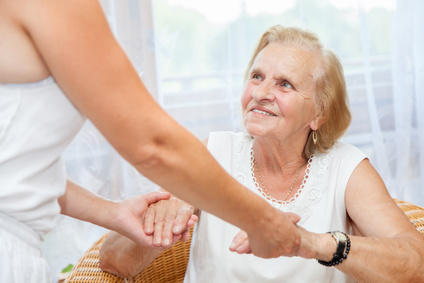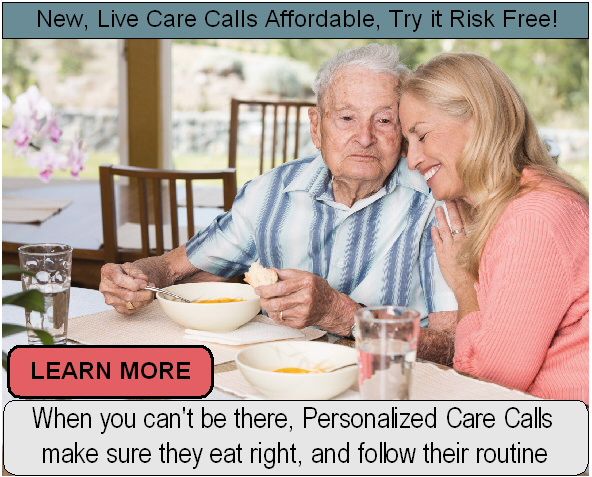How to Tell if an Elderly Person Needs More Care at Home
Download Assessment Tools
ADL (Activities of Daily Living/Self-Care)
IADL (Instrumental Activities of Daily Living/Measures of Independence)
Geriatric Mood Scale (Depression Screen)
It can happen suddenly – a phone call in the middle of the night – or gradually – you begin to notice piled-up bills, dents in the car. However it happens, when a loved one needs help it can change your life. What are the warning signs?
The first thing to do is figure out what kind of problems your elderly loved one faces. Are there specific disease processes that should be addressed? If your loved one hasn't seen a doctor recently, this would be a good place to start, and you should note that seniors are entitled to a free "Welcome to Medicare exam" in their first year in Medicare, as well as an annual wellness exam every 12 months thereafter. An annual eye exam and biannual dental checkup are also important when assessing a loved one's health.
LEARN MORE ABOUT CARE CALLS HERE
10 Warning Signs that a Senior Needs Help at Home

A useful list of 10 Warning Signs was produced by the U.S. Department of Health and Human Services to help older Americans and their families determine if more assistance is needed. Any single behavior change may or may not indicate that an action should be taken, but the list provides a good overview. See the list below to assess whether your elderly loved one will need more help at home.
If an elderly person needs more help at home or if you need to consider assisted living situations for your family member, it is important to do some kind of accurate assessment so you know where to begin. In addition to the warning signs below, SageMinder has also included a variation of ADL and IADL assessments described in more detail below.
Sometimes, we are hesitant to call for professional help. We are not sure if we are over-stepping our boundaries or we are worried about how our parent or other elderly family member will react to an outsider coming into the home to do a formal assessment. The following in home ideas to informally assess the situation may help. The important thing is to start getting a handle on where someone stands and what kind of help may be needed. These tools and ideas here are not intended to replace professional services.
WARNING SIGNS:
- Altered his or her eating habits within the last year resulting in weight loss or gain, having no appetite, skipped meals, or hiding food?
- Neglected personal hygiene resulting in wearing dirty clothes, body odor, bad breath, neglected nails and teeth, sores on the skin?
- Neglected the home so it is not as clean or sanitary as before?
- Exhibited inappropriate behavior by being unusually loud or quiet, paranoid, agitated, making phone calls at all hours?
- Changed relationship patterns such that friends and neighbors have expressed concerns?
- Had physical problems such as accidents, burns, or injury marks resulting from general weakness, forgetfulness, or possible misuse of alcohol or prescribed medications?
- Decreased or stopped participating in activities that were previously important such as playing cards, participating in a book club, dining with friends, or attending religious or other civic meetings?
- Exhibited forgetfulness resulting in unopened mail, piling newspapers, not filling their prescriptions, or missed appointments?
- Mishandled finances such as not paying bills, losing money, paying bills twice or more, or hiding money?
- Made unusual or more frequent purchases such as buying more than one magazine subscription of the same magazine, entering an unusual amount of contests, or increased usage of purchasing from television advertisements?
There is no "score" for these warning signs. However, if you are noticing differences in any of these areas, it may be time to consult his or her physician and get an understanding of what may be happening. Some of these issues are generally related to some normal physical declines and frailty associated with advanced age. However, some are also signs of dementia or other diseases. In some cases, early intervention in certain diseases can halt or slow down the progression of worsening symptoms.
Related:
Care Calls - Automated Calling System to Help Monitor Seniors at Home
Live Care Calls - by trained EMT specialists
Finding the Right Nursing Home
Depression Assessment for Seniors
Often overlooked is an assessment of mood. Many seniors face depression; however, this is not an inevitable part of the aging process. Sometimes, low mood is really just normal grieving. Old age is a time of loss for many - whether the loss is of a spouse, friends, etc. or a loss of their own mobility or indepenence. This Geriatric Mood Scale can help you assess whether your loved one may benefit from talking to his or her doctor about depression. Some of the symptoms of depression result in a lack of motivation to clean the home, eat enough nutritious foods, and/or conduct proper hygeine. Therefore, if left untreated, depression can - and often does - lead to a more rapid decline in physical health. Depression will not necessarily indicate that an elderly person can no longer be independent, but it does often signify a need to help with more assisted living or home care so that the depression does not lead to more problems.

Care Calls
- What are You Waiting For?
*Affordable and Convenient Way to Feel Safe! 1-800-839-3498
Activities of Daily Living (ADL) and Instrumental Activities of Daily Living (IADL) Assessment
Below are two types of assessment tools that are similar to ones you may be given if you visit with your local Agency on Aging or a physician. While these checklists are not intended to replace a professional evaluation, you can use these modified checklists yourself to determine areas in which your loved one may need more assistance or care at home. Professionals use standard scales to assess a patient's ability to cope with life's general demands. Activities of Daily Living Scales (ADLs) are basic daily self-care activities. Instrumental Activities of Daily Living Scales(IADLs) are the basic daily activities needed to live independently in the community. IADL function is usually lost before ADL function. You can get a sense of where your loved one stands by downloading the forms below. Health care at home really needs to begin with an accurate assessment of these ADLs and IADLs.
Download Assessment Tools
ADL
IADL
Geriatric Mood Scale
Next Step - Involving Others and Seeking In Home Care Services
Now is also the time to confer with all concerned parties – relatives, friends, the loved one – about their sense of what kind of help is needed. Different people will notice different things, and all input is valuable in getting a full picture of the situation. A very useful resource for locating services anywhere in the country is the Eldercare Locator, a public service of the Administration on Aging, U.S. Department of Health and Human Services. When considering placing a loved one in a nursing home be sure to do your research and check out the facility first. Once you have an idea of what kind of help will be needed, you can find the resources to get the help you need and begin the process of setting up a care plan for your family member. Again, the person's family physician is best consulted first to make a professional assessment of what kind of help should be considered, but a doctor is often limited to what he or she can see in the office. The information you gather with some of the assessment tools listed here ahead of time will help the physician understand what the person is doing at home and make for a more accurate assessment.

See Also:
Fall Prevention
Hoarding
Getting a Second Opinion
Home Safety Checklist
Care Calls